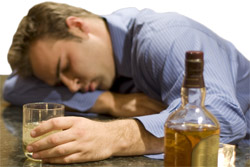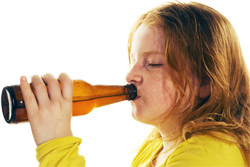- The short-term effects of alcohol
- Immediate cognitive effects of alcohol
- Immediate physical effects of alcohol
- Alcohol-related injury and accident
- Alcohol-related death
- Risky sexual behaviour
- Mental health conditions and suicide
- Alcohol and the community
- Symptoms requiring prompt medical attention
- Who is at risk?
The short-term effects of alcohol
Alcohol is a legal drug in Australia and is commonly consumed by Australians for pleasure and sociability. When consumed in moderation the effects of alcohol are positive, after one standard drink individuals will feel relaxed, confident and talkative. One standard drink consumed in 1 hour will raise the blood alcohol concentration (BAC) of an individual with average build by approximately 0.01 to 0.03%. As the amount of alcohol consumed in a single sitting is increased, the BAC increases proportionately.
Once the BAC has surpassed 0.05%, inhibitions are reduced and judgement and movement are impaired. An individual with a BAC of 0.08–0.15% may exhibit slurred speech, impaired coordination and loss of balance, impaired vision, emotional instability, nausea and vomiting. With a BAC over 0.15%, individuals are classified as being in a high-risk state of intoxication. They may become sleepy, have trouble walking without help, lose bladder control and experience loss of memory and loss of consciousness.
A BAC in excess of 0.3% can lead to coma and death.
 |
For more information on BAC and standard drinks, see Responsible Drinking. |
 |
For more information about the long term effects of alcohol, see Alcohol Consumption: The Long-Term Health Consequences. |
Immediate cognitive effects of alcohol
The most immediate effect of alcohol is on an individual’s cognition (thinking). Drinking alcohol stimulates the release of endorphins and results in feelings of relaxation, increased well-being and reduced inhibitions. Consequently, alcohol consumption can increase an individual’s tendency to engage in risky behaviours.These effects are more prominent in younger individuals who have not developed cognitive processes such as rational thinking and problem solving at a mature level.Individuals under 15 years take greater risks and engage in more anti-social behaviour when consuming alcohol.
Cognition progressively deteriorates with increasing alcohol consumption. Large quantities of alcohol can produce a blackout effect, resulting in the individual being unable to remember what they were doing for a period of time whilst intoxicated.
An individual’s cognitive and verbal ability to deal with conflict also deteriorates with increasing alcohol consumption and the risk of violent conflict increases.
Immediate physical effects of alcohol
As the quantity of alcohol consumed increases, positive feelings such as increased well-being are overtaken by negative physical effects including:
- Drowsiness;
- Loss of balance and difficulty walking;
- Depressed cardio-respiratory systems;
- Deterioration of coordination;
- Slurred speech;
- Blurred vision;
- Slowed reaction times;
- Fine motor skills such as those required for driving are affected to an extent that the risk of injury increases after a single standard drink of alcohol. One standard drink increases the blood alcohol content of a person with average build by approximately 0.01–0.03% (0.01–0.03 g of alcohol per 100 ml of blood), which is just below the legal maximum limit for driving in Australia;
- Impaired endocrine functions are also affected as alcohol consumption suppresses the secretion of pituitary anti-diuretic hormones. These hormones signal the kidneys to reabsorb water, and the suppressed secretion which occurs with alcohol consumption promotes dehydration;
- Nausea, vomiting and coma. When these co-occur they can be fatal as a comatose individual who vomits may choke.
Age-dependent physical effects of alcohol

It is important to note that there are age differences in the effects of alcohol.
Young people tend to maintain their motor function better than their older counterparts who have consumed the same amount of alcohol. Young people also appear less affected by the sedative effects of alcohol. They may therefore stay awake for longer than their older counterparts when consuming alcohol. They may also be more likely to rely on motor skills while intoxicated, unaware of their impairment. For example, a young person might be more likely to think they are capable of driving a car when they are intoxicated.
Alcohol related injury and accident
The key hazard associated with alcohol intoxication is an increased risk of injury.
Injuries and accidents that have been associated with alcohol intoxication include:
- Transport injuries including road traffic accidents and boating accidents;
- Intentional or unintentional poisoning. In Australia, 56% of emergency department presentations for poisoning are alcohol related;
- Fire injury;
- Falls;
- Drowning;
- Exposure to mechanical forces (including machinery accidents);
- Self-inflicted injuries;
- Interpersonal violence.
As a result of this increased accident rate, intoxicated individuals have a higher risk of injury to the head, spinal cord and soft tissues. Alcohol intoxication is also associated with higher all-cause mortality from associated injuries and death from suicide.
Drinking no more than two standard drinks on any given day reduces the lifetime risk of alcohol-related injury to less than 1% (the level of risk designated acceptable by the National Health and Medical Research Council or NHMRC) in healthy men and women. Drinking less reduces the risk further.
Drinking more than two drinks per day increases the risk of alcohol related injury to greater than 1%. Drinking more than four standard alcoholic beverages in a single sitting more than doubles the risk of injury in the following 6 hours. The risk increases further if more drinks are consumed. Young people have a higher risk of alcohol related injury and greater than 50% of serious alcohol related injuries in Australia occur in individuals aged 15–24 years.
Alcohol related death
The rate of alcohol related death rose in the UK from 6.9 deaths per 100,000 people in 1991 to 12.9 deaths per 100,000 in 2005. In the United States, some 90,000 deaths each year are attributed to alcohol abuse. Alcohol-related death is also a significant public health issue in Australia.
The lifetime risk of death from alcohol-related injury increases from less than 1% amongst those who drink once a month or less, to over 5% and 10% amongst female and male daily drinkers, respectively. The risk of death remains less than 1% amongst men and women who never consume more than two drinks in a single sitting.
Gender differences
There are significant gender differences associated with alcohol related death.
In men, the risk of death from alcohol-related injury is greater than risk of death from chronic alcohol-related disease. For example a man who consumes eight standard drinks per day has a 15 in 100 chance of dying from any alcohol related cause in his lifetime. This includes a 5% chance of mortality associated with chronic alcohol-related health conditions and a 10% chance of mortality due to alcohol-related injury.
Women, on the other hand, are more likely to experience morbidity from chronic alcohol related conditions than sudden injury. A woman drinking eight standard drinks daily has a 14% chance of alcohol-related death; she has an 8.5% risk of dying from a chronic health condition and a 5.5% chance of death from an alcohol related injury.
Cultural differences
Deaths from alcohol related causes occur twice as frequently amongst the Aboriginal and Torres Strait Islander population compared to the non-Indigenous population, despite a lower proportion of the Aboriginal and Torres Strait Islander population consuming alcoholic beverages. Suicide is a particularly prominent cause of alcohol-related death in this group.
Differences in age
Alcohol-related death is a particularly acute problem amongst young people. In Australians aged 14–17 years, 13% of deaths can be linked to alcohol consumption. Each week a 14–17 year old Australian dies from an alcohol-related cause and a further 60 are hospitalised.
Risky sexual behaviour

- Initiate sex earlier in life;
- Are less likely to use a condom during their first sexual encounter;
- Are more likely to contract a sexually transmitted disease.
Young women who consume alcohol are more likely to experience pregnancy as a teenager. The association between teenage pregnancy and alcohol consumption may arise because individuals who consume alcohol are predisposed to other risky behaviours, including unprotected sex.
There is also evidence that men become more sexually aggressive when drunk and women who are drunk are more likely to condone male sexual aggression.
The risk of sexual coercion for females increases with intoxication and alcohol is particularly likely to be involved in instances of acquaintance rape. Over half of all rape cases on university campuses in the United States (most of which are acquaintance rapes) occur after the victim, perpetrator or both have consumed alcohol.
Mental health conditions and suicide
Alcohol consumption and excessive daily alcohol consumption are associated with an increased risk of mental health conditions. In addition those who binge drink are more likely to attempt or complete suicide.
There is also evidence that individuals with existing mental health conditions are more likely to consume excessive quantities of alcohol, sometimes as a form of self-treatment. While the associations between mental health conditions and excessive alcohol consumption are often long-term, they result in an immediate increased risk of suicide, particularly amongst young people. Adolescent males and females are 17 and three times more likely to attempt suicide whilst intoxicated respectively. In these instances, depression and intoxication appear to work synergistically to greatly increase a young person’s risk of suicide.
Alcohol and the community
The short-term effects of drinking not only affect the individual who is consuming the alcohol but can also affect the community. Over 70% of the prisoners in Australia had a positive BAC before they committed the crimes that led to their imprisonment. 40% of domestic violence cases and 16% of child abuse cases involve alcohol.
Drinking can also lead to a hangover the day after the alcohol is consumed. Hangovers can contribute to loss of productivity in the workplace as well as in the classroom.
 |
For more information on hangovers, see Alcohol Hangovers. |
Symptoms requiring prompt medical attention
If an individual has drunk to the extent that they have developed alcohol poisoning, immediate medical attention is required. Symptoms of alcohol poisoning include:
-
Mental confusion;
-
Coma;
-
Vomiting;
-
Seizures;
-
Slow breathing (less than eight breaths per minute);
-
Irregular breathing;
-
Bluish skin colour;
-
Paleness.
These symptoms can occur before the individual has passed out. This is common during binge drinking. It is also important to remember that alcohol is a depressant and can inhibit breathing and the gag reflex, which increases the risk of coma and choking.
 |
For more information on binge drinking, see Binge Drinking. |
 |
For more information about helping someone who has drunk too much alcohol, see Alcohol: How to Help a Drunk Person. |
Who is at risk?

- Young people have been well documented to take greater risks and exhibit more anti-social behaviour when under the influence of alcohol. A significant proportion of Australian youth drink alcohol on a regular basis (70% of 17 year olds drink at least once a month), thus the majority of Australian adolescents are at risk of alcohol related injury;
- Individuals taking medications which may interact with alcohol;
- Individuals with mental illness, who may display more intense symptoms of alcohol intoxication. Individuals with mental disorders including depression, attention deficit hyperactivity disorder and bipolar disorder are more likely to abuse drugs, including alcohol;
- Individuals working in hospitality, manufacturing, construction, retail and agriculture, as these occupational groups are more likely to drink at levels associated with increased risk of injury;
- Individuals with personality traits including impulsiveness, extraversion, inhibition and dominance are more likely to drink large quantities of alcohol more frequently than individuals who do not display these personality traits;
- Individuals residing in regional and remote areas, as these individuals are more likely to drink at levels which increase the risk of alcohol-related injury. Heavy drinking is also more common in socially deprived areas;
- Individuals who are Aboriginal or Torres Strait Islanders, as this group is more likely to drink at levels which increase the risk of alcohol-related injury.
References
- South Australia Drug and Alcohol Services: Alcohol and its effects [online]. SA Health, 2010 [cited Feb 2011]. Available from: [URL link]
- Newbury-Birch D, Walker J, Avery L, et al. Impact of alcohol consumption on young people- A systematic review of published reviews [online]. Newcastle University; 2009 [cited 2 October 2010]. Available from: [URL link]
- Australian Guidelines to Reduce Health Risks From Drinking Alcohol [online]. National Health and Medical Research Council; 2009. [cited 2 October 2010]. Available from: [URL Link]
- Alcohol Alert: Alcohol’s damaging effects on the brain. 2004; 63 [online]. Oickville, MD: National Institute on Alcohol Abuse and Alcoholism; 2004 [cited 2 October 2010]. [URL Link]
- Rehm J, Baliunas D, Borges GLG, et al. The relation between different dimensions of alcohol consumption and burden of disease: an overview. Addiction. 2010; 105: 817–843. [Abstract]
- Report of the DGAC on the Dietary Guidelines for Americans, 2010: Chapter D7- Alcohol [online]. Dietary Guidelines Advisory Committee; 2010 [cited 28 September 2010]. Available from: [URL Link]
- Stephens R, Ling J, Heffernan TM, et al. A review of the literature on the ognitive effects of alcohol hangover. Alcohol Alcoholism. 2008; 43(2): 163-70. [Full Text]
- Abbey A. Alcohol-related sexual assault- a common problem amongst college students. J Stud Alcohol. 2002; Supp14: 118-28. [Abstract | Full Text]
- National Institute on Alcohol Abuse and Alcoholism: Parents help your teens party right at graduation [online]. NIAAA, 2005 [cited Feb, 2011]. Available from: [URL link]
All content and media on the HealthEngine Blog is created and published online for informational purposes only. It is not intended to be a substitute for professional medical advice and should not be relied on as health or personal advice. Always seek the guidance of your doctor or other qualified health professional with any questions you may have regarding your health or a medical condition. Never disregard the advice of a medical professional, or delay in seeking it because of something you have read on this Website. If you think you may have a medical emergency, call your doctor, go to the nearest hospital emergency department, or call the emergency services immediately.








